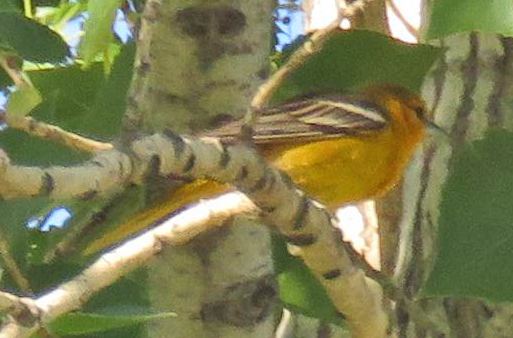| Common name: |
Baltimore Oriole x Bullock's Oriole hybrid |
 |
| Scientific name: | Icterus galbula | |
| Date: | 6-12-2020 | |
| Time: | 7:30am | |
| Length of time observed: | Off and on for over an hour | |
| Number: | 1 | |
| Age: | adult | |
| Sex: | Female | |
| Location: | Tracy Aviary's Jordan River Nature Center | |
| County: | Salt Lake | |
| Latilong: | 40.69387125 -111.92218378 | |
| Elevation: | 4300ft | |
| Distance to bird: | 10m at closest | |
| Optical equipment: | 10x50 Nikon Binos, Canon SX50 Digital Camera | |
| Weather: | Mostly sunny,calm and 70F | |
| Light Conditions: | good | |
| Description: Size of bird: | Medium sized passerine | |
| (Description:) Basic Shape: | passerine | |
| (Description:) Overall Pattern: | overall uniformly bright yellow-orange | |
| (Description:) Bill Type: | ||
|
(Description:)
Field Marks and Identifying Characteristics: |
We had just finished a practice bird survey and were discussing the results,
when Tim, John and I spotted an Oriole foraging in an Elm nearby. Naked eye it
was very bright yellow-orange so I assumed a male Bullock's, but when we put the
binos on it we all noticed it had no black markings on the throat like a male
Bullocks. We then watched it for some time as it repeatedly visited and feed
young in a nest. Uniformly bright yellow orange on the torso and face, including
the belly and flanks, it had 2 white wing bars, a long slightly decurved silver
bill, some smudgy black markings on the crown, nape and back and a faint eyeline.
There were a couple Bullocks Oriole's nearby but they did not interact with this
bird and no male was seen visiting the nest. (see photos)
** This record was withdrawn from
consideration as a Baltimore Oriole. Cameron Cox: "The single most reliable
trait for females is where is the yellow/orange brightest. In female Baltimore
its on the chest, in Bullock's it is in the malar area. In this bird it appears
the bright orange malar connects to the bright orange chest which leads to the
conclusion that it is a hybrid. The wing coverts also have much more white in
them than I would be comfortable for in a Baltimore. I've seen a couple of
similar birds on the Gulf coast of Texas and have probably passed off others,
for as Bryant mentioned, this isn't the typical appearance of a hybrid and at
first glance is very BAOR like. "Typical" for this hybrid pair is very much a
moving target though. One of the times when I've been in the hybrid zone in
eastern Colorado I remember seeing five birds in a row, all hybrids, all quite
different. In appearance they seem to function as a hybrid swarm though hybrids
are less fit than either parent species as they oddly inherit the molt
strategies of both parents and end up doing two prebasic molts pre year." |
|
| Song or call & method of delivery: | Heard giving a chatter call, faster and not as scratchy as a Bullocks. Also a clear single whistle | |
| Behavior: | Actively foraging, including fly catching, then delivering food to chicks in a nest | |
| Habitat: | Riparian cooridor of Jordan River, foraging in tall cottonwoods and elms | |
| Similar
species and
how were they eliminated: |
Bullock's Oriole-Males have a black throat,back,nape and crown, and bold white wing patches. Even 1st year males
have a black throat. Females are very dull with a pale gray belly and back, the
yellow is restricted to the head and tail and is very dull olive-brownish
yellow, not bright or orangish. Direct comparison with both sexes. Chatter call
of Bullock's different and noted in the field, Bullocks is slower and scratchy,
more striking, Chatter call from this bird was faster and less harsh and more
subtle. Hybrid Bullock's X Baltimore was harder to rule out, very few references or photos of female hybrids, but Steven Mlodinow has some photos on eBird of some female hybrids in Colorado, and they seem to have a paler belly more like a Bullocks than this bird. Hybrids are very rare and unexpected outside hybrid zone in the western Great Plains, so would be unexpected in Utah. Hybrids should only be considered if something is wrong for a true species and this bird seems fine for a Baltimore female. Overall Baltimore greatly out numbers hybrids as a whole so a hybrid would be statistically less likely, as well as out of range. But most importantly no field marks are off for Baltimore and suggest Bullocks Hooded Oriole, female would be more yellowish with a longer tail and bill, don't make a chatter call similar to this birds Orchard and Scott's Oriole females very yellow, not orangish. Streak-backed seems very unlikely, calls different as well,more harsh, female has black throat. |
|
| Previous
experience with this & similar species: |
Yes, several males and females in Texas, Colombia and one female in Utah at Salt Lake International Center in October 2012 | |
| References consulted: | Audubon Bird of North America app, Sibley, eBird | |
| Description from: |
Notes taken at the time of the sighting From photo(s) taken at the time of the sighting |
|
| Observer: | Bryant Olsen | |
| Observer's address: | 84102 | |
| Observer's e-mail address: | ** | |
| Other observers who independently identified this bird: |
Tim Brown, John Middleton, Linda Johnson and Angela Dean were with me, Matthew
Pendelton and several other later. |
|
| Date prepared: | 6-12-2020 | |
| Additional material: | Photos | |
| Additional comments: | eBird checklist: https://ebird.org/checklist/S70345612 | |